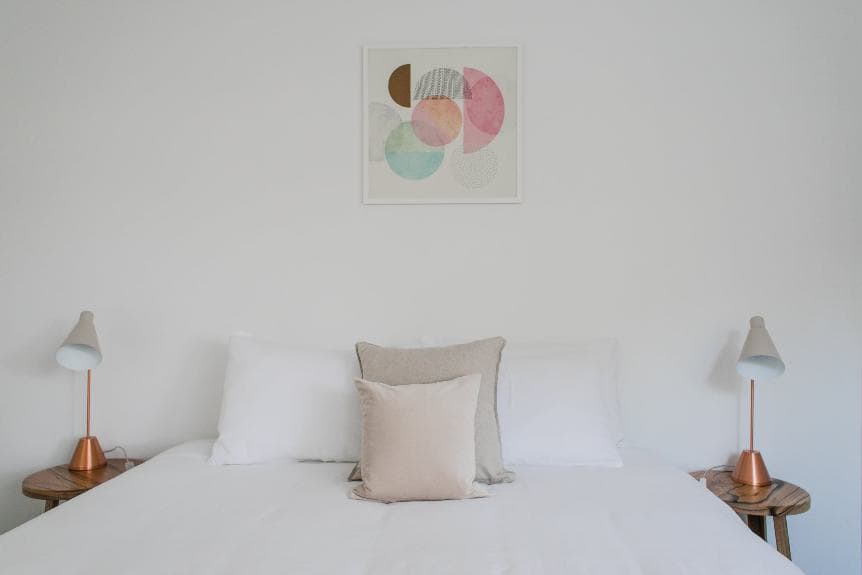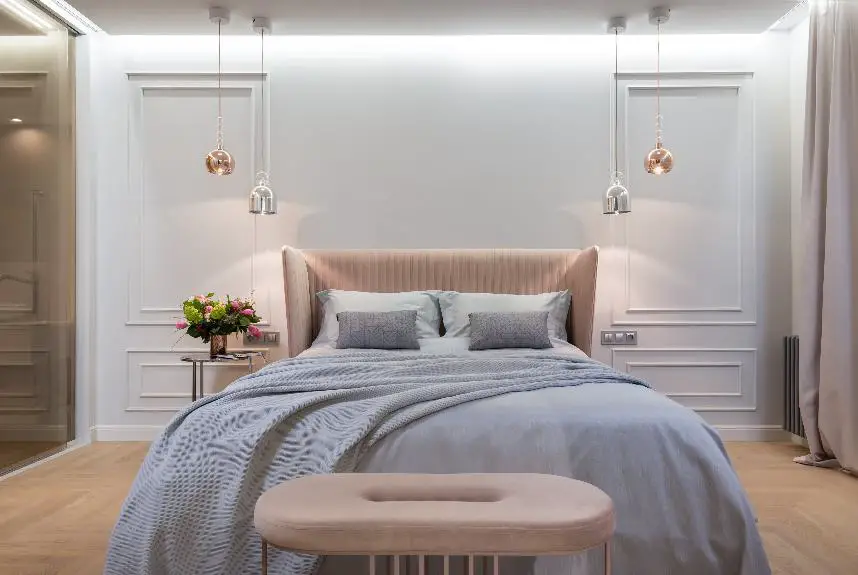Bedside lamps do not have to match. The choice depends on personal preference and the style of the bedroom. Matching lamps can create a formal and balanced look, while different lamps can add a unique and lively touch.
Designers consider aspects like size, color, and theme when choosing lamps. The decision should also consider the lamps' practical use and the atmosphere one wants to achieve in the bedroom.
Symmetry Vs. Asymmetry
In a bedroom's design, symmetry and asymmetry offer different aesthetics. Symmetry creates a balanced and orderly look, often seen with matching bedside lamps that frame the bed and provide a sense of harmony. This traditional design approach appeals to our desire for balance.
On the other hand, asymmetry, using mismatched bedside lamps, brings a unique and dynamic feel to the room. It breaks from the expected, adding personality and interest through a mix of lamp shapes, sizes, or styles. Asymmetry can make the decor more lively and engaging.
For a cohesive asymmetrical look, bedside lamps should have some common features, such as similar colors or materials that tie in with the room's theme. This creates a balanced variety without looking random.
Choosing between symmetry and asymmetry for bedside lamps depends on personal taste and the overall design intent of the bedroom. Both options should complement the room's atmosphere and meet its functional requirements.
The Impact on Ambiance
Matching bedside lamps contribute to a bedroom's ambiance and aesthetic. These lamps are key in setting a room's atmosphere. Proper lighting is crucial for achieving a specific mood, whether for relaxation or inspiration. Matching lamps create balance and symmetry, often seen in traditional settings, and can help create a peaceful environment.
Mismatched bedside lamps can add variety and a modern touch. Different styles, shapes, or colors can provide visual interest and personal expression while offering necessary lighting. This variety can make the space feel more dynamic and suit a casual or eclectic style.
The overall impact on ambiance depends on how the lamps interact with the room's design elements. The lighting should complement the room's textures, furniture, and colors to enhance the mood. The decision to use matching or mismatched bedside lamps can significantly affect the room's feel.
Design Flexibility and Creativity
Homeowners often choose bedside lamps that vary in style, material, and color to add personal flair to their bedrooms. These lamps not only provide light but also serve as decorative pieces that can match or contrast with existing decor.
Selecting the right lamps requires balancing aesthetics and practicality. Homeowners may experiment with different styles, such as combining a modern lamp with a vintage one, to enhance the room's look. This can also highlight other bedroom features, like artwork or a color theme.
Choosing mismatched bedside lamps can break away from traditional symmetry, creating a more eclectic and customized space. This decision can also meet the specific needs of the users, with one lamp designed for reading and another for a softer light.
The goal is to achieve a bedroom design that aligns with personal taste while providing a welcoming environment. The ability to mix and match lamps contributes to a bedroom's style and individual character.
Matching Vs. Coordinating
Matching bedside lamps can create symmetry in a room, while coordinating lamps can provide visual harmony with shared design elements. The choice between matching and coordinating depends on personal preference and the intended look of the bedroom.
Matching lamps offer a traditional, uniform appearance, while coordinating lamps allow for a more varied and personalized style.
Coordinating lamps can mix different styles, sizes, and colors that complement each other. For example, two lamps might differ in height but have similar shades or materials. This approach maintains balance with a less strict symmetry. Coordinating elements, such as color or texture, can bring the room together effectively.
Functionally, coordinating lamps can address individual needs. One lamp could be larger for reading, and another smaller for ambient light. This shows that design can be practical without compromising on style.
The decision to use matching or coordinating bedside lamps depends on personal taste and the design of the room. Both options should enhance the bedroom's atmosphere and suit the users' needs.
Considering Room Themes
Choosing bedside lamps that match a room's theme requires considering design elements for both visual appeal and functionality. Bedside lamps are an accent light source and a decorative element that can influence the room's overall feel. When the theme is specific, like French Country or Shabby Chic, select lamp bases in off-white or neutral colors to complement these styles.
The size of the bedside lamps should fit with the nightstands and bed to maintain balance. A large lamp may be too much for a small nightstand, while a small lamp may not stand out on a larger furniture piece. To blend the lamps with the room's theme, they should contrast with the nightstands in color, texture, or shape in a way that adds to the room's design rather than clashing with it.
Trying various lamp styles and sizes can help to find the right fit for the room's theme. The aim is to create a cohesive space where the lamps enhance the room's design narrative and provide useful accent lighting. These fixtures should help tell the room's decor story, whether they match or coordinate with other elements.
Practical Considerations
Bedside lamp features such as adjustable arms and dimming capabilities are important for convenience and creating the desired atmosphere in a bedroom. When choosing bedside lamps, both functionality and design are important. The right lighting can improve the bedroom's comfort and usability for activities like reading, relaxing, or navigating the space at night.
The size of bedside lamps should match the nightstands they sit on and the size of the bed. Large lamps can overpower a small nightstand, while small lamps may not provide enough light next to a large bed. The brightness and color of the light are also important; a warm, gentle light can help create a comfortable environment for sleep.
Ease of use is important for lamps that will be used often. Adjustable arms let users focus light where needed, which is ideal for reading or for those who wish to minimize disturbance to others at night. Dimming features allow for adjustable brightness, offering bright light for tasks or softer light for relaxation.
Making Your Choice
To choose the right bedside lamp, start by evaluating different designs and features. Consider the size of the lamps in relation to your nightstands and bed to ensure they fit well and provide enough light for tasks like reading.
When selecting a lamp, it should match your bedroom's style, such as French Country or Shabby Chic. Neutral-colored lamp bases can blend with the room's color palette for a unified look.
Functionality is important. Look for lamps with adjustable arms for targeted lighting and dimming capabilities for a relaxing atmosphere.
Set a budget to find affordable options that don't sacrifice style or quality. Prices vary, so a budget will help you focus on lamps that offer good value.
Deciding whether bedside lamps should match is up to personal preference. Take into account size, style, functionality, and budget to choose lamps that suit your space and taste.





